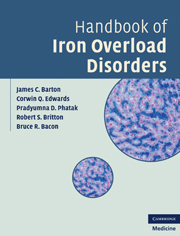Book contents
- Frontmatter
- Contents
- Foreword by Anthony S. Tavill
- Preface
- 1 History of iron overload disorders
- 2 Normal iron absorption and metabolism
- 3 Iron toxicity
- 4 Tests for hemochromatosis and iron overload
- 5 Complications of hemochromatosis and iron overload
- 6 Insulin resistance and iron overload
- 7 Infections and immunity
- 8 Classical and atypical HFE hemochromatosis
- 9 Heterozygosity for HFE C282Y
- 10 Porphyria cutanea tarda
- 11 Mitochondrial mutations as modifiers of hemochromatosis
- 12 Hemochromatosis associated with ferroportin gene (SLC40A1) mutations
- 13 Hemochromatosis associated with hemojuvelin gene (HJV) mutations
- 14 Hemochromatosis associated with hepcidin gene (HAMP) mutations
- 15 Hemochromatosis associated with transferrin receptor-2 gene (TFR2) mutations
- 16 Iron overload associated with IRE mutation of ferritin heavy-chain gene (FTH1)
- 17 Hereditary hyperferritinemia-cataract syndrome: IRE mutations of ferritin light-chain gene (FTL)
- 18 Iron overload in Native Africans and African-Americans
- 19 Hereditary atransferrinemia
- 20 Divalent metal transporter-1 (SLC11A2) iron overload
- 21 Iron overload associated with thalassemia syndromes
- 22 Iron overload associated with hemoglobinopathies
- 23 Iron overload associated with pyruvate kinase deficiency
- 24 Iron overload associated with congenital dyserythropoietic anemias
- 25 Hereditary sideroblastic anemias
- 26 Pearson marrow–pancreas syndrome
- 27 Acquired sideroblastic anemias
- 28 Hereditary aceruloplasminemia
- 29 Friedreich ataxia and cardiomyopathy
- 30 Pantothenate kinase (PANK2)-associated neurodegeneration
- 31 Neuroferritinopathies
- 32 GRACILE syndrome
- 33 Neonatal hemochromatosis
- 34 Iron overload due to excessive supplementation
- 35 Localized iron overload
- 36 Management of iron overload
- 37 Population screening for hemochromatosis
- 38 Ethical, legal, and social implications
- 39 Directions for future research
- Index
- Plate section
- References
38 - Ethical, legal, and social implications
Published online by Cambridge University Press: 01 June 2011
- Frontmatter
- Contents
- Foreword by Anthony S. Tavill
- Preface
- 1 History of iron overload disorders
- 2 Normal iron absorption and metabolism
- 3 Iron toxicity
- 4 Tests for hemochromatosis and iron overload
- 5 Complications of hemochromatosis and iron overload
- 6 Insulin resistance and iron overload
- 7 Infections and immunity
- 8 Classical and atypical HFE hemochromatosis
- 9 Heterozygosity for HFE C282Y
- 10 Porphyria cutanea tarda
- 11 Mitochondrial mutations as modifiers of hemochromatosis
- 12 Hemochromatosis associated with ferroportin gene (SLC40A1) mutations
- 13 Hemochromatosis associated with hemojuvelin gene (HJV) mutations
- 14 Hemochromatosis associated with hepcidin gene (HAMP) mutations
- 15 Hemochromatosis associated with transferrin receptor-2 gene (TFR2) mutations
- 16 Iron overload associated with IRE mutation of ferritin heavy-chain gene (FTH1)
- 17 Hereditary hyperferritinemia-cataract syndrome: IRE mutations of ferritin light-chain gene (FTL)
- 18 Iron overload in Native Africans and African-Americans
- 19 Hereditary atransferrinemia
- 20 Divalent metal transporter-1 (SLC11A2) iron overload
- 21 Iron overload associated with thalassemia syndromes
- 22 Iron overload associated with hemoglobinopathies
- 23 Iron overload associated with pyruvate kinase deficiency
- 24 Iron overload associated with congenital dyserythropoietic anemias
- 25 Hereditary sideroblastic anemias
- 26 Pearson marrow–pancreas syndrome
- 27 Acquired sideroblastic anemias
- 28 Hereditary aceruloplasminemia
- 29 Friedreich ataxia and cardiomyopathy
- 30 Pantothenate kinase (PANK2)-associated neurodegeneration
- 31 Neuroferritinopathies
- 32 GRACILE syndrome
- 33 Neonatal hemochromatosis
- 34 Iron overload due to excessive supplementation
- 35 Localized iron overload
- 36 Management of iron overload
- 37 Population screening for hemochromatosis
- 38 Ethical, legal, and social implications
- 39 Directions for future research
- Index
- Plate section
- References
Summary
Prevention or amelioration of disease is possible if risk or susceptibility factors can be identified and effective interventions are available. For example, phenotype testing of neonates for rare disorders such as phenylketonuria, other heritable amino acid metabolism defects, galactosemia, and congenital hypothyroidism is universal or mandatory because timely diagnosis and management avert disease manifestations. In diverse, typically adult-onset disorders, it is feasible to detect pathogenic germline or acquired mutations in individuals, family members, or population cohorts. Some clinicians rely on DNA analyses to assess the risk of single-mutation disorders such as familial breast and colon cancer, hemochromatosis, and Huntington disease. Among these examples, the risk of symptoms is great in Huntington disease, but the potential to prevent symptoms and consequent death is low. In HFE hemochromatosis, the capability to prevent disease due to iron overload is great, but the risk that subjects with a “positive” genetic test will develop severe iron overload is relatively low. Many physicians and non-medical members of the public have difficulty understanding the indications for, and interpreting results and consequences of, genetic information for risk assessment or diagnosis.
Across certain disorders, some studies and many anecdotes suggest that the potential for misuse and misunderstanding is greater for DNA-based tests than for phenotype tests, even one like hemoglobin electrophoresis that has diagnostic and predictive value equivalent to that of corresponding DNA-based testing. In the 1990s, controversy about the privacy, confidentiality, and fairness of use of genetic information increased.
- Type
- Chapter
- Information
- Handbook of Iron Overload Disorders , pp. 347 - 363Publisher: Cambridge University PressPrint publication year: 2010

